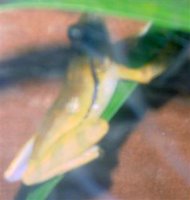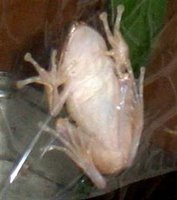Brown Tree frogs
Introduction:
Brown tree frogs can make fascinating pets. I find these amphibians readily in my backyard during the wet season. However, I generally only keep these frogs for a couple of weeks before I release them – they don’t seem to cope too well with captivity. If you catch frogs and plan to release them make sure not to miss the end of the rainy season – I would hate to have to release a frog in the dry season. I have observed four such frogs in the past three years.
Difficulties:
Wild-caught tree frogs do not seem to settle into captivity very well. They don’t eat easily and generally just try to escape all the time. There’s no way you could possibly be able to “pet” these pets… However, certain tree frogs that are available on the market make much easier pets to take care of. Some of these species can be found on http://www.calm.wa.gov.au/plants_animals/reptiles/advice/tree_frogs.html Being amphibians, all frogs can absorb chemicals, etc through their skin so A) never use any detergent or anything similar in your frogs aquarium and B) always thoroughly wash
 your hands if you happen to have to touch them (keep your hands moist).
your hands if you happen to have to touch them (keep your hands moist).Rewards:
These frogs are incredibly active. Their leaps are quite simply spectacular. And, besides, they make fairly awesome photographic subjects…
Housing:
I have personally seen one of these frogs leap approximately four feet. The bigger the frog, the farther they can leap. Therefore, if kept in a very small aquarium they will batter themselves quite badly. The ones I have kept always seemed to do fine in a 20 gallon aquarium with a lid that is taped on so the frogs can’t escape. I even kept one is a large cardboard box that had been lined with duct tape and had a thin layer of transparent plastic in front. This setup seemed to work quite well. I think that the darkness and the cave-like design of this enclosure actually helped that frog calm down. However, A) it detracts very much from your enjoyment of the frog, B) it makes it harder to feed the frog and C) the humidity eventually destroys the enclosure. Do not try to keep these frogs in cages. Slamming themselves against the metal bars or chicken wire may result in injury. Insect-screen enclosures might be interesting though… Never tried it myself.
These frogs need a few basic essentials. First of all, at least two plants they can leap between. If your frog is attaching itself to the side of it’s aquarium during the day (being nocturnal) then you need to redesign your setup. At night you can expect your frog to investigate and will unquestionably ‘perch’ on the aquarium itself (as in the photo). The first thing you might need to add is hiding places. Generally, large leaves are all you need: the frogs will cling to them upside-down and thus conceal themselves (obviously, if you plan to keep your frog for more than a few days the plants will need light, but most certainly do not leave your frog exposed to direct sunlight). Otherwise, be creative. One design that worked for me was a plastic cup attached to the top of the aquarium with a couple of twigs secured inside it.
Humidity is pivotal. If your frog dries up it will dry. It’s probably a good idea to provide a large water bowl in the frog’s habitat, both for humidity and for them to swim in. If you are using an aquarium, just fill the bottom six centimeters or so with water. Mist you
 r aquarium daily. Do not leave it exposed to direct sunlight, but remember that being cold-blooded your frogs will be more active if the temperature is relatively warm. Normal room temperature of about 27, 28 degrees Celsius works well. Air-conditioned rooms constantly at 10 degreed Celsius are definitely not suitable.
r aquarium daily. Do not leave it exposed to direct sunlight, but remember that being cold-blooded your frogs will be more active if the temperature is relatively warm. Normal room temperature of about 27, 28 degrees Celsius works well. Air-conditioned rooms constantly at 10 degreed Celsius are definitely not suitable.I have only ever kept one frog at a time, but I see no reason why two frogs of similar size cannot be kept in a suitable aquarium. Do not catch baby frogs – I’m positive they’d die. My general rule is that the bigger the animal (relative to its species) the more likely it is to survive.
Feeding:
If your wild-caught tree frog eats you are lucky. Here are a few tips to increasing your chances. Any, true exotics lover must have mealworms, if not bloodworms somewhere in the house. I need a constant supply of live ones for my other pets. Of the four frogs I kept I saw one eat two mealworms in two weeks and another one would eat live bloodworms every few days for the month I kept it. To offer these foods I attach a few, small, plastic ‘dishes’ (about 1cmX1cm) to the side of the aquarium and place the food items on them. For wild caught frogs the prey must be alive. If you insist on observing (as, I must admit, I do) I suggest you sit in a way that you are below the aquarium, instead of staring straight at the frog. I generally lie under the table I keep aquaria on with only my head poking out from under it. You must remember that free frogs are predominantly nocturnal, so they won’t eat if the lights are on too bright. I prefer to turn off the light and turn on a lampshade on the other side of the room (yes, I keep my frogs in my bedroom – and there’s nothing wrong with that!).
Final words of advice:
I have never ‘lost’ a brown tree frog. I mean this in two senses. First of all, these frogs are escape artists so make sure your housing is suitable. Secondly, none of my frogs – even though they were all wild caught – have ever dies while in captivity. However, the one that refused to eat did loose a bit of condition in the week I kept it. I have no way of knowing whether these frogs survive once I release them (which is why I’ve only kept four in the past three years). I have no reason to believe otherwise, but I do not have confirmation that they all survived once released. As with any animal you catch and then release, be rational. Don’t wait until your frog is skin and bones before you release it. Remember that worldwide amphibian populations are dwindling…


0 Comments:
Post a Comment
<< Home